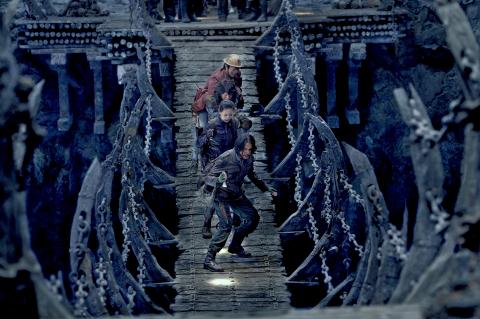It makes no sense to expect Mojin — the Lost Legend (尋龍訣) to make sense. The latest production by Chinese director Wuershan (烏爾善) is an adventure-fantasy movie designed to thrill and entertain, depicting a bunch of action heroes braving zombie armies in search for a stone with magic power. Based on Chinese writer Zhang Muye‘s (張牧野) immensely popular adventure series, Ghost Blows Out the Light (鬼吹燈), this is a precisely-crafted work of entertainment featuring a star-studded cast and stunning CGI effects, showing that China is catching up with Hollywood in manufacturing blockbuster entertainment.
The film opens with three adventurers entering a subterranean mausoleum. Through off-screen narration by Wang (Huang Bo, 黃渤), we learn that they are Mojin Xiaowei (摸金校尉), an ancient school of tomb raiders once commanded by Chinese emperors.
The story cuts to New York City in the late 1980s, where Wang and his two partners, Hu (Chen Kun, 陳坤) and Shirley (Shu Qi, 舒淇), now live, having retired from tomb raiding. Tired of hawking “Chinese treasures” in the city’s backstreet, Wang returns to his old trade by taking on a mission for a mysterious, wealthy businesswoman (Liu Xiaoqing, 劉曉慶), who wants an ancient meteorite called the Equinox Flower, which has the power to resurrect the dead and is believed to be buried in an ancient tomb of a Khitan princess in Inner Mongolia.

Photo courtesy of Vievision Pictures
The mission brings Wang’s mind back to 20 years ago, when he and Hu joined a communist youth group traveling through the vast steppes of Inner Mongolia, where Wuershan grew up, at the height of the Cultural Revolution. Here, the country’s communist past serves as a source of ridicule and laughs, humorously rendered in a sequence in which the communist youths, determined to rid the masses of superstition and old customs, go on trashing whatever is deemed traditional and end up being slaughtered by an army of dead Japanese soldiers-turned-zombies in a crypt.
The expedition leads the heroes back to the exact site where the bloodshed took place two decades ago, where they will find out what awaits them in the crypt.
Knowledge of the Cultural Revolution is not required to enjoy Mojin, as the movie is made to engage a global audience. Cultural particulars are turned into plot gimmicks as Chinese emperors’ mausoleums become the playground for the modern action heroes, who use Bagua (八卦), or the eight trigrams, to solve mysteries and hunt treasures.
The movie is lavish, packed with eye-dazzling action and fantastic plots, making it feel right at home among the Lara Croft: Tomb Raider films. Wuershan’s visual panache renders the whole film a pure spectacle, especially with the underground mausoleum, where the bulk of the story takes place.
There are doses of gore and thrill thrown in, as the zombies look vivid and fearsome but quickly crumble when being hit as if they had stepped out of The Mummy series.
Shu makes a gorgeous action heroine. She is athletic, agile and plays it cool most of the time. But her love-hate pas de deux with Chen’s character is stiff and tiresome. The occasional outburst of whining and pouting makes her not quite up there with Angelina Jolie’s Lara Croft.
Chen is cut out for a dashing action hero, albeit a rather indistinct one. Huang ends up stealing much of the attention with his strong presence, offering hyperactive comic relief along with his sidekick, played by Xia Yu (夏雨). The latter, however, carries a zaniness so overbearing that one wishes a zombie could knock him out and keep him unconscious till the end credits roll.

June 9 to June 15 A photo of two men riding trendy high-wheel Penny-Farthing bicycles past a Qing Dynasty gate aptly captures the essence of Taipei in 1897 — a newly colonized city on the cusp of great change. The Japanese began making significant modifications to the cityscape in 1899, tearing down Qing-era structures, widening boulevards and installing Western-style infrastructure and buildings. The photographer, Minosuke Imamura, only spent a year in Taiwan as a cartographer for the governor-general’s office, but he left behind a treasure trove of 130 images showing life at the onset of Japanese rule, spanning July 1897 to

In an interview posted online by United Daily News (UDN) on May 26, current Chinese Nationalist Party (KMT) Chairman Eric Chu (朱立倫) was asked about Taichung Mayor Lu Shiow-yen (盧秀燕) replacing him as party chair. Though not yet officially running, by the customs of Taiwan politics, Lu has been signalling she is both running for party chair and to be the party’s 2028 presidential candidate. She told an international media outlet that she was considering a run. She also gave a speech in Keelung on national priorities and foreign affairs. For details, see the May 23 edition of this column,

The Taiwan People’s Party (TPP) on May 18 held a rally in Taichung to mark the anniversary of President William Lai’s (賴清德) inauguration on May 20. The title of the rally could be loosely translated to “May 18 recall fraudulent goods” (518退貨ㄌㄨㄚˋ!). Unlike in English, where the terms are the same, “recall” (退貨) in this context refers to product recalls due to damaged, defective or fraudulent merchandise, not the political recalls (罷免) currently dominating the headlines. I attended the rally to determine if the impression was correct that the TPP under party Chairman Huang Kuo-Chang (黃國昌) had little of a

At Computex 2025, Nvidia CEO Jensen Huang (黃仁勳) urged the government to subsidize AI. “All schools in Taiwan must integrate AI into their curricula,” he declared. A few months earlier, he said, “If I were a student today, I’d immediately start using tools like ChatGPT, Gemini Pro and Grok to learn, write and accelerate my thinking.” Huang sees the AI-bullet train leaving the station. And as one of its drivers, he’s worried about youth not getting on board — bad for their careers, and bad for his workforce. As a semiconductor supply-chain powerhouse and AI hub wannabe, Taiwan is seeing